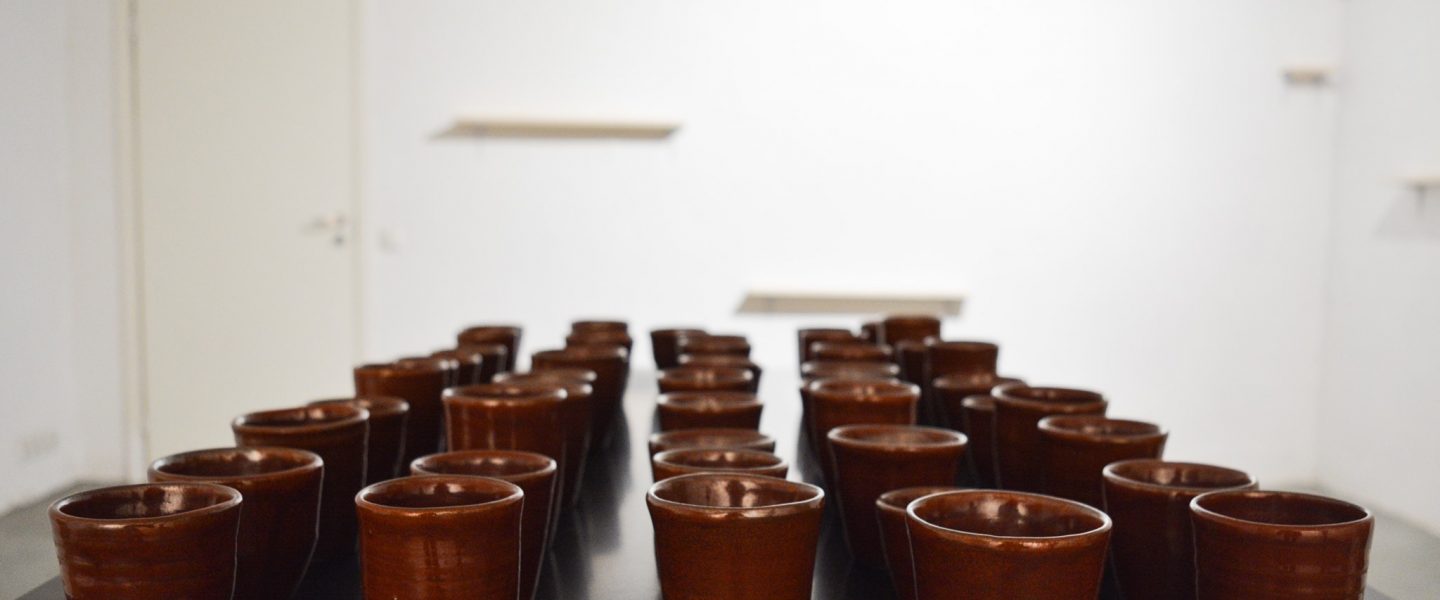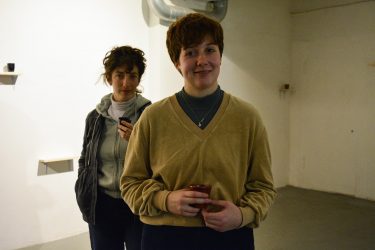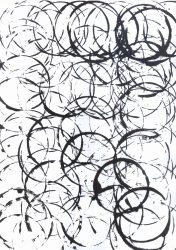
100 Cups by Lorna Phillips. Photo by Anita Moser.
Lorna Phillips (1999), had her exhibition “100 cups” at Vent Space from 13th till 19th of November 2019. She is a girl from Scotland and she is doing her Erasmus exchange studies in sculpture at EKA. We met up on a cozy evening at school, in visual studies leisure room, where we sat in darkness and quietness surrounded by some Christmas lights. Next to a cup (cups made by Lorna) of tea, we had a nice chat about Lorna’s ceramics, childhood and her thoughts of life and art.

Kerly Ritval: So, does tea have a big role to play in your life?
Lorna Phillips: Well, I have always been brought up with the tea. I guess maybe it is a British thing as well. My dad can drink like 25 cups of a tea in a day, very easily. We just constantly drink tea at home, it is a home thing I think.
But in school, do you drink coffee or tea?
Always tea! I try to make time to have tea breaks.
Tell me, when did you make your very first cup?
I learned how to swirl on the wheel maybe three years ago now. Doing an apprenticeship with a family. Like they were a family of potters and they just took us for the summer. And we just went down to this maybe three times a week. And I don’t know, we just kind of spent time with them and they were really friendly. So I just learned it from a family, it was very special. And from then on, I have just practiced and practiced. I am quite like I am caught by a bug.
Have you become better in a way?
Yes, definitely, it took me a long time, to be able to swirl properly.
So, is it very difficult to sit by the bench and make a normal cup?
I think it is kind of intense concentration. And it is definitely like a skill you have to learn. But once you know, and I think, as long you practice, it’s not so difficult.
I remember the exhibition “Kalle” from October, in ISFAG, the cellar next to EKKM, and there you had these super fragile thin cups.
Yeah, that was also slightly different cause, we went to drinking out of those, but quite a lot of those smashed, that was kind of the idea. Some of them fell, because birds came in to the space, and because cups had gathered water in them, the birds were drinking the water out of them and then they would land and roll off and smashed.
Did you also study ceramics in Edinburgh?
No, sculpture. They don’t actually have ceramics department in Scotland.
But you went to study sculpture, because of the cups?
My first year was a general art year, I had mainly done painting before. And then came the apprenticeship and after, I just got stuck on clay, I couldn’t stop, so that just kind of stayed with me. Like, I do different things, but this is just always there, which is nice.
So, do you have a relationship with clay?
Yes, definitely. It’s because I played piano as well and I have to find a piano after a certain amount of time and play. It’s the same thing with a clay. And there is something about clay as well, as a material. It is really human, so close to flesh and skin, so soft and also how it changes over time. There something really not primitive, but kind of primitive about clay.
Where came this idea to make 100 cups?
It was 101 actually, even though, it was called 100. It was a lie. Well 100 as a number was nice. I wanted to split a room, to have two groups. So I thought the 100 would be good. Especially in terms of percentages. And then I figured that, if I was going to split the room, I didn’t want to do it evenly. I wanted to have some kind of imbalance. Even though nobody really knew there was one. So I did 51 of a black and 50 of a red.
And how did the exhibition look like?
I had 51 cup on one table and 50 on another. 51 were in a smaller back room and and 50 in a bigger room. And as people came in, they started to mix together and come out and go in to the room and put cups on the selves or on the floor, things like that. But I wasn’t sure about the number of people who would come. And I definitely didn’t think there will be 100 people coming, so maybe some of the cups would be left. But it’s funny, because people started having one drink and then putting the cup away and took a new one, so it was this disposable with this ceramics.
So, did you give the task to people?
Yeah I just said like, help yourselves and have a drink, put them wherever you want to put them. It was quite relaxed and the atmosphere was nice.
The cup thing is your personal thing? I guess in school you have other projects to do?
Yes, it mixes in. I am very interested about home, and familiarity and what makes a space? So, at the moment I am making furniture. And also collecting things. Cause my family are carpenters, so its been really nice to learn how to make furniture. And yeah, making books and collecting objects, from my memories here or people or drawings of things.
But I don’t know, when you are coming in a room every day and you start not noticing the things, because you see them so often. For instance, I have mugs at home, what we have had since we were kids. And they had cartoons or something on them, but you actually don’t see them anymore because you see them every day. It is just a familiarity thing.
I really liked your exhibition about the cups, because often when you go to ceramics exhibition, you are not allowed to touch them, or you are not allowed to drink from them. But this is the best way how to interact with people, and I like this handmade effect by it. What reminds me William & Morris company, which is very British thing of course, and you are not British…or are you?
Yes, because my parents are English. But I am brought up in Scotland.
We are carpenters family, so we moved to a house and then my dad fixed this house. Then, we moved to a next house and my dad would fix the next house. So, I always lived in houses, that were half fixed. When they were fixed and nice we would move to the next one. So that’s kind of why I like to make these installations and things in the space. Because that’s where I have always been in. That’s what my dad does, to me, my dad is a sculptor. Cause he goes around and makes homes for people. And then he leaves and gives them to somebody else.
But, since you have moved so much, then there are these things, you carry with you, what are always with you and then the things start to be your home.
Yeah, we have always had the same bed sheets. The same weird floral green and pink patterns on the bed sheets. I think we moved like four times, not like too much, but quite a lot.
Do you have more ideas about your cups?
I would like to make a 1000 cups, for like production making. I think it is really nice, to just set the task and do it again and again. So I think maybe 1000 for over few weeks, like doing a 100 in 3 days was a bit intense.
A 100 in 3 days! How many hours did you put in there?
Probably like 15-16.
So 1000 is next one, and then, are you going bigger and bigger?
1000 is good for production making, but also, I kind of enjoy people coming to exhibition to have an happening and using the things. So I think, it would be nice for doing it again. Perhaps together with some kind of installation with a furniture, maybe bring the furniture and cups together. Cause I think that’s what was missing from the exhibition at Vent Space, somewhere to sit.
So, the last question, who is your favourite artist?
Just like traditional British slipwet pottery, like Hannah McAndrew and Doug Fitch.

